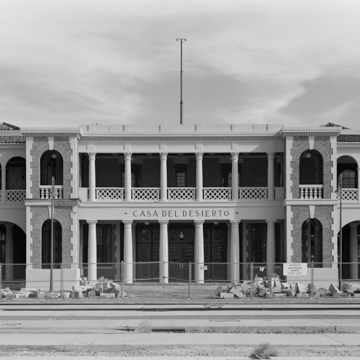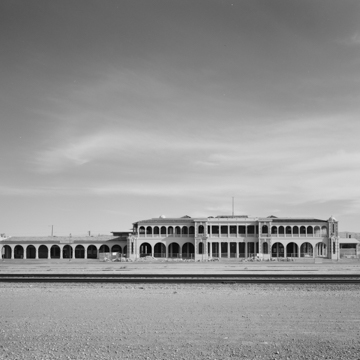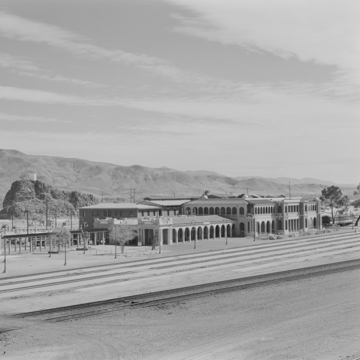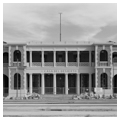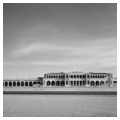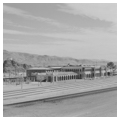You are here
Harvey House Railroad Depot
The horizontal lines of the historic Harvey House Railroad Depot in Barstow contrast sharply with the jagged rock outcropping in the desert landscape behind it. Constructed in 1910 and opened in 1911, the depot complex was the latest addition to the Fred Harvey line of restaurants, hotels, and gift shops that served patrons of the Atchison, Topeka and Santa Fe Railway (AT&SF). Fred Harvey began operating food and lodging services for the AT&SF in 1876. Prior to this partnership, hungry train passengers would rush to find a quick meal, usually overpriced, while the train idled at the station for twenty minutes before continuing toward its destination. Harvey identified a need for greater service and quality. He entered into a business arrangement for the Santa Fe whereby the railway would construct hotels and restaurants at its stations, while Harvey and his staff would manage the establishments with a high standard of efficiency and decorum. The Fred Harvey houses were the first national chain of restaurants. So successful was Harvey’s system, the “Harvey Girls” who worked as waitresses in the restaurants became nationally recognized for introducing civility into the “Wild West.”
The Casa del Desierto station, built in 1911, replaced a previous Harvey House depot that had burned down in 1908. The plague of fire coupled with flooding from the Mojave River led the railway to initiate major infrastructural redevelopments in the area that significantly altered the town of Barstow. In addition to the laying and realigning of new tracks, redirecting the channel of the river and adjusting the grade of Stockyard Hill, the AT&SF contracted for the construction of the new depot-hotel in addition to various operational structures.
Touted in a 1911 Los Angeles Times article as the “largest building in the West for the exclusive use of one railroad company,” the depot complex originally featured three main buildings connected by covered, arcaded walkways and separated by courtyards. Seen from the tracks, the right end of the depot featured the hotel and dining room, while ticket offices and waiting rooms occupied the center structure. At the left was the reception room and a pergola led to the recreational facility toward the rear. A smaller structure at the front left handled the station baggage. Casa del Desierto also provided unique facilities that catered to the Santa Fe employees, including reading rooms, gymnasium, swimming pool, and sleeping accommodations.
The buildings feature elements of Spanish Colonial Revival and Classical Revival styles, with some Moorish Revival influence. The archways of the arcades and the red tile roofs are defining features of the Spanish style. Elements of the buildings are representative of the contemporary Beaux-Arts public architecture then in fashion. Some of these features include the columns in the portico, the use of small pediments as ornamentation, and decorative red brick and elaborate concrete embellishments on the corner towers and front bay. The towers are capped with either pointed roofs or painted domes, the latter giving a subtle Moorish design. Inside the Harvey House, the original terrazzo floor, poured three feet thick, remains a defining element. Local craftsmen also contributed to the construction and design of the interiors. Fred Harris, a Barstow resident at the time the depot was constructed, installed the cabinets, staircases, and wood fixtures. A Mr. Murgua, also of Barstow, handcrafted the copper fixtures.
Beginning around 1900, the design of Santa Fe’s Harvey Houses shifted away from traditional Victorian revival modes and instead began to borrow from the Southwest’s Spanish and Native American history and the distinctiveness of the landscape to produce a regionally inspired architecture, a transition led by architect Mary Elizabeth Colter. In 1902, Colter began a professional relationship with the Fred Harvey Company, initially working on a handful individual Harvey projects before accepting a permanent position in 1910. She designed buildings throughout the American Southwest, employing a rustic blend of American Indian and Spanish influences to create a sense of historical regionalism. Structures such as Hermit’s Rest and Lookout Studio near the Grand Canyon demonstrate her elegant use of natural materials such as logs and native stone.
Though some sources name Colter the architect of Casa del Desierto, it is more likely that the depot was designed by Francis W. Wilson. None of the historical literature on Colter’s career indicate her connection to Casa del Desierto. Furthermore, Colter’s unique designs typically engaged with more organic and natural materials such as logs and stone, forging a strong connection between her buildings and their regional setting. The use of concrete and brick in the Barstow depot would be a departure from her aesthetic style. Like Colter, Wilson also worked with the AT&SF and the Fred Harvey Company, designing the El Garces Hotel and Depot in 1908 and the Fray Marcos Hotel and Grand Canyon Depot in 1909–1910. It is his earlier design for the Southern Pacific Railroad Passenger Station (1902) in Santa Barbara, however, that bears a striking resemblance to Casa del Desierto, particularly the prominence of arcades and red tile roofs. Wilson’s designs were typically more formal and classical in style than Colter’s, and Casa del Desierto fits into Wilson’s demonstrated repertoire.
As train travel declined due to the increasing role of the automobile and as the AT&SF began serving meals on their trains, the patronage of the Harvey House declined. A series of photographs produced by Jack Delano for the U.S. Farm Security Administration/Office of War Information indicates that, by 1943, the restaurant and public spaces of the depot were only used by the police and by AT&SF employees. Eventually abandoned, the AT&SF planned to demolish the complex but responded to local protests that the buildings should be saved. In 1975, Casa del Desierto was added to the National Register of Historic Places; the following year it became a California Historical Landmark. After a decade of restorations, prolonged by an earthquake in 1992, the station reopened in 1999 as an Amtrak Station. It now also houses the Western America Railroad Museum, the Mother Road Route 66 Museum, and the Barstow Area Chamber of Commerce and Visitors Bureau.
References
Allaback, Sarah. The First American Women Architects.Urbana: University of Illinois Press, 2008.
“Barstow Proud of New Hotel: Casa del Desierto Beautiful Oasis in Waste.” Los Angeles Times, February 21, 1911.
Bellomy, Michael, “Harvey House (Casa Del Desierto),” San Bernardino County, California. National Register of Historic Places, 1975. National Park Service, U.S. Department of the Interior, Washington, D.C.
Berke, Arnold, and Alexander Vertikoff. Mary Colter, Architect of the Southwest.New York: Princeton Architectural Press, 2002.
Grattan, Virginia L. Mary Colter: Building Upon the Red Earth.Grand Canyon, AZ: Grand Canyon Natural History Association, 1992.
James Robbins and Associates, “Casa Del Desierto,” San Bernardino County, California. Historic American Buildings Survey, 1994. Prints and Photographs Division, Library of Congress (HABS CAL 36-BAR,1-).
Ramounachou Moon, Germaine L. Barstow: Depots and Harvey Houses.Barstow, CA: Mojave River Valley Museum Association, 1980.
Starr, Kevin. Material Dream: Southern California through the 1920s. New York: Oxford University Press, 1990.
Writing Credits
If SAH Archipedia has been useful to you, please consider supporting it.
SAH Archipedia tells the story of the United States through its buildings, landscapes, and cities. This freely available resource empowers the public with authoritative knowledge that deepens their understanding and appreciation of the built environment. But the Society of Architectural Historians, which created SAH Archipedia with University of Virginia Press, needs your support to maintain the high-caliber research, writing, photography, cartography, editing, design, and programming that make SAH Archipedia a trusted online resource available to all who value the history of place, heritage tourism, and learning.

